"If you only look at a person through one lens, or only believe what you're told, you can often miss the truth that is staring you in the face." -Kevin Spacey
One of the most powerful ideas from Einstein's theory of Gravity -- General Relativity -- is that any massive object in the Universe not only causes a gravitational force on other masses, but also bends light!
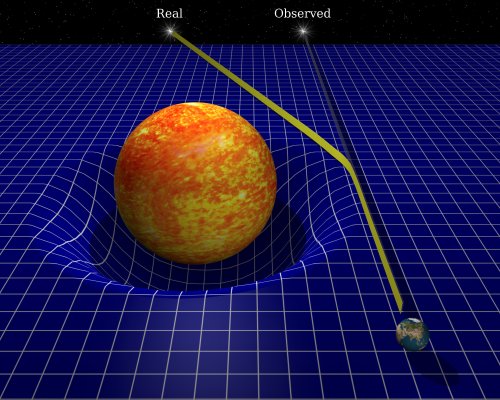 Image credit: Dave Jarvis of http://davidjarvis.ca/dave/gallery/.
Image credit: Dave Jarvis of http://davidjarvis.ca/dave/gallery/.
(Link to David Jarvis' gallery.) This was confirmed in 1919 by observing the positions of stars during a total solar eclipse; the stars closest to the Sun had their apparent position shift due to the gravitational bending of the light rays!
How does this happen? The mass acts just like a lens does, bending the light rays! Only, instead of being a glass, plastic or acrylic lens, it's a gravitational lens.
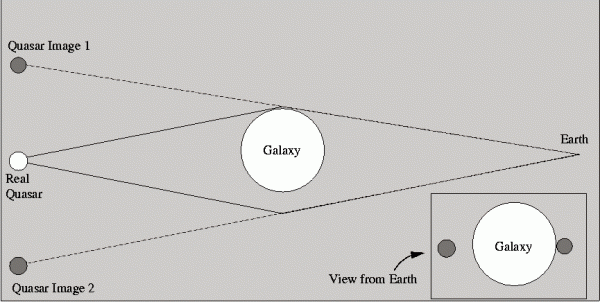
In 1936, Fritz Zwicky, the same guy who theorized the existence of dark matter, realized that distant galaxies could act as gravitational lenses also! After all, they have mass, and if there are other objects emitting light behind them, that light could get bent towards us!
Although it wasn't discovered observationally until 1979, this phenomenon, known as strong gravitational lensing, has given us some of the most remarkable images in the Universe.

Those weird arcs in the above image -- of cluster Abell 370 -- are due to gravitational lensing. Gravitational lensing is great for distorting the light from background objects, and therefore for distorting the shapes of lensed galaxies.
Any other neat effects of gravitational lenses?
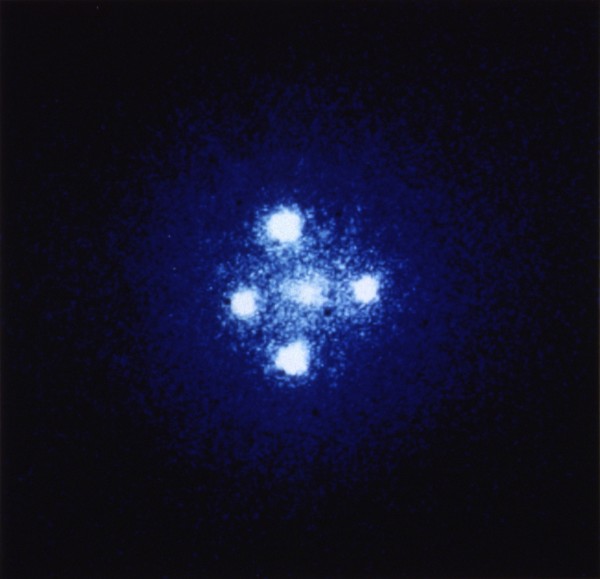
Multiple images! Do you see what looks like five bright blue stars (with crosshair-style rays) in the image above? Those are actually five multiple images of the same quasar! In many of the images, you can actually see the host galaxy that the quasar resides in!
In fact, just two years ago, we discovered an incredible alignment of three objects nearly all in a perfect row from our vantage point. What does that give us?
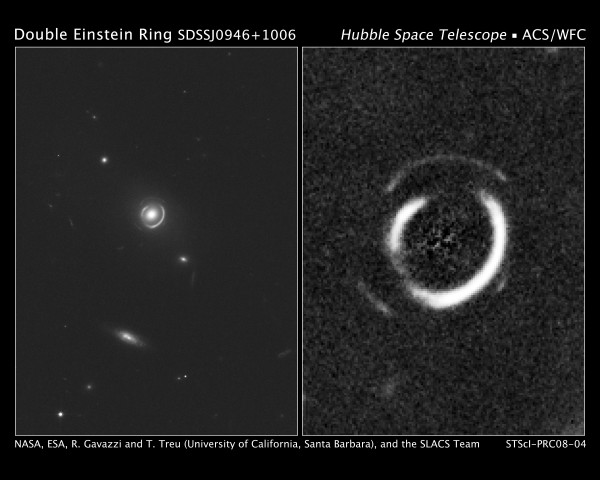
Two almost perfect, concentric rings!
It turns out that there's only one thing that determines how much (and what type of) bending we get, given your galaxies in a certain place. All that matters is the mass of the thing acting as a gravitational lens! So if I put down a distant galaxy in the background and then a lens in the foreground, by observing what the background light does, I can easily figure out how much mass is in the lens. In fact, there are software packages out there that will even do it for you.
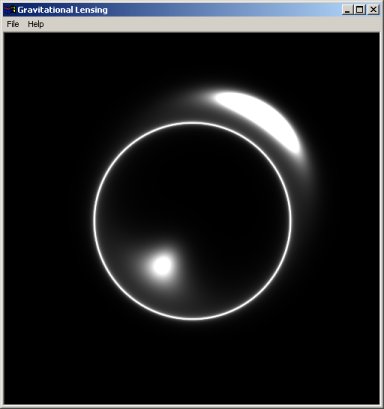
This is true whether it's a galaxy, a cluster of galaxies, or an individual star doing the lensing. But that's usually not such a big deal. After all, by observing a galaxy, a cluster of galaxies, or an individual star, we can usually learn a lot about its mass from other means.
But you know what would be a huge advance?
If we could find something of unknown mass acting as a gravitational lens!
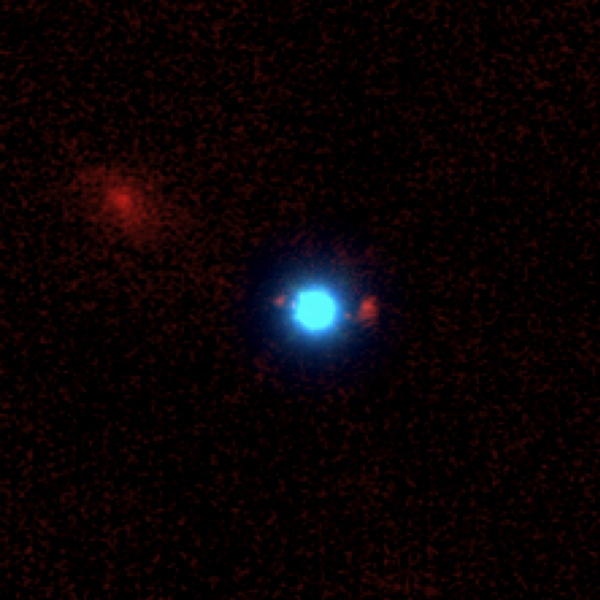
Well, there's a new paper out (with some great new images) by two joint teams from Caltech and Ecole Polytechnique Federale de Lausanne, respectively, led by George Djorgovski and Georges Meylan. And they found exactly that, for the first time.
Instead of a star, galaxy, or cluster of galaxies, the object acting as a lens is a quasar (shown below), where the galaxy its found in is completely obscured by the blazing core!

Under normal circumstances, we'd never be able to know the mass of the galaxy housing this quasar. But because of the gravitational lens, we can figure it out!
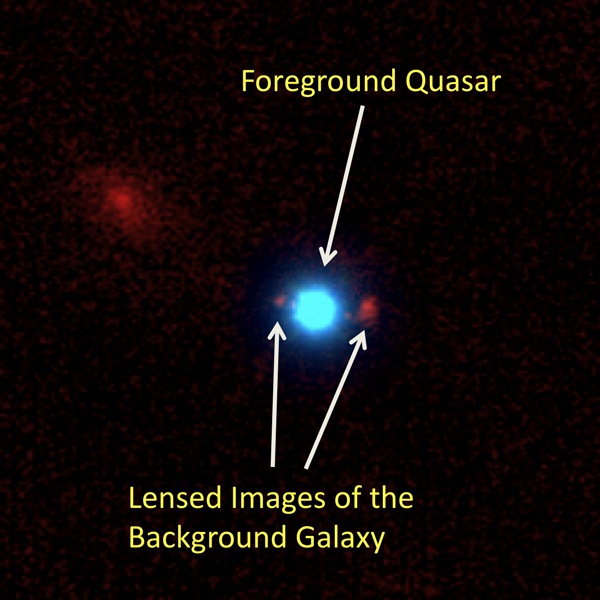
Want to know something that makes this even more amazing? This image was taken from the ground, with all of the Earth's atmosphere to contend with! It is amazing how good adaptive optics have gotten!
And thanks to these observations, this is the first time we've ever seen a quasar act as a strong gravitational lens!

And what they found is that there's a mass of 22 billion Suns within the innermost kiloparsec (about 3,000 light years) of this quasar and its host galaxy!
This is the very first time this technique has been used to measure the mass of a quasar's host galaxy, and the very first time we've seen a quasar act as a gravitational lens! You can bet it won't be the last. So, welcome to the birth of a new way to do astronomy, and enjoy the images and analysis from this first discovery!

Does the fact that the images were taken on the ground (thus subjecting the light to more distortions and filters) affect the accuracy of the mass estimation of the lensed galaxy? How big of a deviation would we expect if we took the same image throught the hubble telescope and measured the mass of the same galaxy?
Also I had a blog request. Was wondering if you could do a one that explains gravitational waves, what they are, how they behaive, and how LIGOs is attempting to directly observe them. Thanks, and great post btw. Firsts in science are always exciting.
@ crd2:
Almost any observation from the ground (radio, not so much) is affected by travelling through the atmosphere and by things like light pollution. Which is why observatories tend to be built at high altitude, dry places that are far away from man-made light sources.
I only took a brief look at the abstract but they made observations in the K-Band (radio).
Radio telescopes are not affected nearly as much by the above problems (though they have their own) so ground based observations do not have to correct (or not as much) for these issues.
@crd2
Forgot to answer your last question, Hubble does not make observations at the wavelengths that the paper describes.
Opps. I should have looked more closely b/f i asked my question. Thanks for the info Malark.
Ethan, could these effects be compound?
What I mean from that is could the Image of a quasar be split and then light years away be split again, are the five bright blue stars a result of lensing or compound lensing or would this be unlikely?
Yet another great and thought provoking post.
Although the observation is a unique and the application of gravitational lensing theory where quasar itself is the lens,and not the object being lensed, is remarkable indeed,but, there is a fundamental question that remains unanswered - How do you know that lensing is even occuring here ?
It would be a very crude way of observation,if the only proof that there is only a single source - whose light is being lensed - behind the quasar is a photograph with two almost identical and symmetrical objects surrounding a bright quasar.It is very much possible that those two images are of two distinct galaxies.In that case,all calculations using gravitational lensing principles would be misleading.
It would be appreciated if some alternate concrete evidence - and the methodology used to ascertain - of the existence of single source in the background of quasar is given here.
@abhishek
Most likely is they look at the spectrum of the images, if they are the same then it is, most likely, the same object.
@Ethan
They say that the mass is 22,000 Million suns (I guess that means our sun) in a radius of 3,000 light years.
So 5.14 Solar masses/Cubic light year.
Isn't that very high for such a young object, even if most of the mass is in a central black hole.
I'm not disouting the calculations and results, just wondering how quickly large galaxies form
Correct me if I'm wrong but couldn't you figure the distribution of mass within an object by how it lenses the image behind it?
Have there been any cases of observed lensing that require a DM halo?
How do you know that lensing is even occuring here ? ... It is very much possible that those two images are of two distinct galaxies.In that case,all calculations using gravitational lensing principles would be misleading.
Apply Occam's Razor. Gravitational lensing is a far more parsimonious explanation than the coincidence of two separate galaxies (w/identical spectra) being serendipitously arranged on both sides of a quasar as viewed from Earth. I'm also assuming this null hypothesis was thoroughly vetted prior to paper publication.
I am confused by any lensing that yields point images. We would expect, in the simplest case of a radially symmetric mass, to see a halo. Of course, there are plenty of masses that aren't radially symmetric, but with those I'd expect to see something like a blurred pair of arcs, not two point sources. To obtain bilaterally symmetric point images, wouldn't you need a mass distributed evenly along the line perpendicular to the line joining the two point images?
@UberMalark: "I only took a brief look at the abstract but they made observations in the K-Band (radio)."
I believe you're confusing the 2.2 micron NIR K band with the radio K. (A&A is also a bit loose regardling the style convention of italicizing the IR bands and setting the radio one roman.)
Very nice.
"But you know what would be a huge advance?"
Pardon me for not understanding. I understand that this is very good science: but I don't understand why this is a "huge advance". Can someone give me more perspective? Thanks.
Hi. Does anybody know if it´s possible to curve light ray again and again, so many times that the ray back to its own source? If it´s possible it would be also possible to see the image of the Earth coming from millions of years ago.
Hi. Does anybody know if it´s possible to curve light ray again and again, so many times that the ray back to its own source? If it´s possible it would be also possible to see the image of the Earth coming from millions of years ago.
@Mirek: In theory, yes, although incredibly improbable. Also, with all of the curvings and distance, the photons would end up incredibly dispersed, so you'd likely get a lone photon at that point if such an improbable path was taken at all, so "image" wouldn't really be descriptive of what you might get.
It is probably possible to get a proper image with the right distribution of oddly shaped mass distributions, but not of the earth. The arrangement of bodies that would yield that effect would be incredibly specific and complex, and that geometry, whatever it might be, isn't present (and won't exist at a time when humans can live here) around the earth.
Most macrolensing events involve a quasar in the lensing mass, and this event is a quasar in a galaxy. The host galaxy is certainly contributing heavily to the lensing. I'm not seeing how this is a first in any way as far as the observation is concerned. The write-up seems to suggest that this is the first lensing event observed in which the lensing body was of unknown mass. This seems to imply that we have known the mass of every single lens ever observed before this, which seems rather unlikely.
Maybe I'm misinterpreting something in the claim. Can someone clarify this please? Thanks : )
Quite exciting & thought provoking, as all the science firsts ( along with their comments ) !
How do you know that lensing is even occuring here ?
Another argument : we know that a quasar is relatively massive (it's a galaxy after all), and we see light from background object(s) very close by. The question is : how could this light not be "lensed" when passing so close to the quasar ?
About the "first" : gravitational lensing is quite unique way to measure the total (i.e., including dark) mass of any object acting as a lens. This is the first time that one can measure the mass of a quasar+host (i.e., a very special type of galaxy), in a new independent way. We did not know the mass of every lens observed before in advance -- that's the point : the analysis of the observed lensing phenomenon is what allows you to measure the mass of the object responsible for the space-time warp. And so here a new type of object acting as a gravitational lens was found.